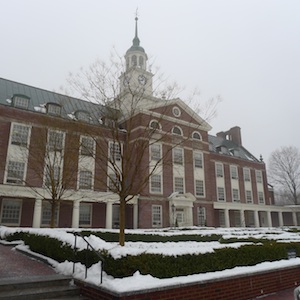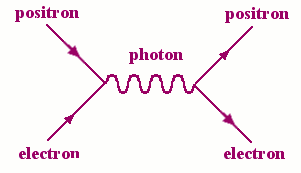In February this year we were lucky enough to interview Freeman Dyson at the Institute for Advanced Studies (IAS) in Princeton, USA. Dyson is now 89 and still does physics every day in his first floor office at the Institute. He told us the Institute will let him use the office as long as he can make it up the stairs! Dyson is a legend in theoretical physics, having played a vital role in developing quantum electrodynamics (which describes the fundamental units and interactions of the electromagnetic force) and many other areas of physics throughout one of the most exciting centuries in science. He was very patient with his explanations to two novices. Here is an edited version of our interview that we hope conveys his generous nature, wit and intellect.
You can also read our four part series of articles on the development of quantum electrodynamics.

Freeman Dyson in the grounds of St. Johns College after delivering the Dirac Lecture, June 2003.
Photo and copyright Anna N. Zytkow.
Plus: You started off in mathematics, how did you end up in theoretical physics?
Dyson: The fact was I was never really a real mathematician. I was always an applied mathematician that happened to be in number theory, which is of course supposed to be pure mathematics. Number theory is really applied mathematics [using techniques], mostly from the 19th century, to find out things about numbers. It's similar to what you do in physics, [using mathematics] to find out things about atoms. So the switch to atomic physics really wasn't a big switch. It was essentially the same mathematics being used, just on different problems.
I was always interested in physics, but I came to Cambridge as a student in 1941 in the middle of the war. All the applied [mathematicians] were away fighting the war so there was essentially no physics going on. But there were these very famous pure mathematicians — such as G. H. Hardy and John Littlewood — whom I had all to myself. It was a wonderful time to be a student with these big famous mathematicians around. They had hardly any students so I got to know them all and became, for the time being, a pure mathematician.
But I hadn't lost the interest in physics and after the war I made the switch. I found Nicholas Kemmer in Cambridge who gave me this book [his treasured 70 year-old copy of Gregor Wentzel's Quantum theory of fields (in the original German), that he'd retrieved from a nearby shelf at the beginning of our interview, referring to it has "his bible"]. It was Wentzel's book, published in Vienna during the war. It was a precious treasure that book; I think there were only two copies in England at that time and I had one of them. Kemmer was supposed to be my colleague, but he knew all about quantum field theory, [the mathematical language used to describe quantum physics], because he had been a student of Wolfgang Pauli before the war. Kemmer was a tremendous piece of luck for me, he was probably the best informed person there was in England.
America was very empirical, nobody had heard of this stuff. They considered it a sort of Italian opera — extravagant and irrational entertainment — they didn't consider it useful. So I came to America as a student in '48 and I was then the teacher, teaching all these famous people, Hans Bethe and Richard Feynman, about quantum field theory.
The years of 1947-48 were a great time. It was just enormous luck to come into physics at that moment, because the experiments were roaring ahead. In those days it didn't take ten years to do an experiment, it took about ten days. Microwaves caused a tremendous revolution in atomic physics. Instead of using just optical light to measure the [atomic] levels, you could do it a thousand times more accurately with microwaves.

The Institute for Advanced Study in Princeton.
For the first time [scientists] got a really accurate picture of the hydrogen atom, the supposed simplest atom. What they found disagreed with Paul Dirac's prediction. [Willis Lamb experimentally observed that two energy levels, which Dirac predicted would be the same, were in fact different.] This is the famous Lamb shift — which was discovered just when I came to America. Everybody was very excited about [the Lamb shift]; for the first time there was a real discrepancy with the theory [quantum physics]. Bethe solved the problem as far as the physics was concerned. But the problem was if you calculated [Bethe's explanation] with the existing [mathematics], it [gave you infinite answers], and that was the big question.
All the giants from the old times were still around, people like Werner Heisenberg, Erwin Schrödinger, Dirac and Robert Oppenheimer. They all thought we needed radically new physics [to solve this problem], they all had their theories of changing the whole basis of physics, introducing completely new ideas. But every one of them turned out to be wrong.
There came along these three bright young men, Richard Feynman and Julian Schwinger and Sin-Itiro Tomonaga, and each of them solved the problem [of the infinities] in his own way. All of them got the same answer, which obviously was right. I had the tools of quantum field theory, which they didn't have. So I was able to put them all together and demonstrate it was all quite simple. I polished up the mathematics so that it did give finite answers.
Plus: So do you think it was your mathematical background that helped?
Dyson: Yes. Schwinger of course was good at calculations, but he didn't like quantum field theory. He was this young prodigy, and he came and gave this talk here [at the IAS] , explaining his calculation, and Oppenheimer said "You know when other people give talks it's to tell you how to do it. But when Julian Schwinger gives a talk, it's to tell you that only he can do it." (Laughter).

A Feynman diagram. Find out about its use in the Plus article Tying it all up.
Feynman had his completely original way of doing things which he didn't think of as quantum field theory, but it really is. Usually the way physics is done, since Newton, is you write down equations, the laws of physics, then you calculate the results. Feynman skipped all that, he just wrote down the pictures [known as Feynman diagrams] and then wrote down the answers. There were no equations. These Feynman diagrams were his invention and turned out to be in fact a pictorial description of quantum fields.
Plus: Where did Feynman's concept come from? Where do revolutionary ideas come from?
Dyson: It's true of almost every great idea that you really don't know afterwards where it came from. Our brains are random, that's of course nature's trick for being creative. I have identical twin grandsons, they have all the same genes but they don't have the same brains: they develop independently. So these two identical young men have totally different brains, all the internal structure is essentially random. And that's how our minds turn out to be so powerful: they don't have to be programmed, they can invent things just by random chance. I think that's where [great ideas] come from. All really good ideas are accidental. There's some random arrangement of things buzzing around in somebody's head, and it suddenly clicks.
You can read a previous interview with Dyson on Plus and also our four part series of articles on the development of quantum electrodynamics.
About this article
Rachel Thomas and Marianne Freiberger are the editors of Plus. They interviewed Freeman Dyson in Princeton in February 2013.